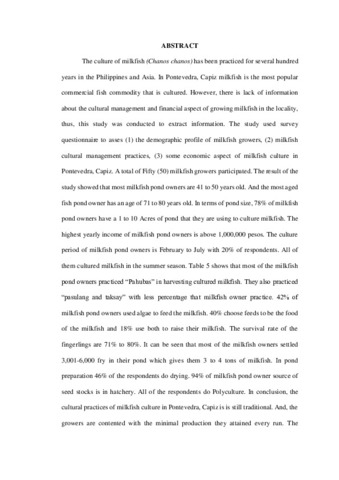The Cultural management and some economic aspect of milkfish (Chanos chanos) culture in Pontevedra, Capiz
| dc.contributor.advisor | Dela Calzada, Rey J. | |
| dc.contributor.author | Barredo, Charmen B. | |
| dc.contributor.author | Guillen, Rhealyn B. | |
| dc.date.accessioned | 2024-04-25T05:41:06Z | |
| dc.date.available | 2024-04-25T05:41:06Z | |
| dc.date.issued | 2023-06 | |
| dc.identifier.citation | Berredo, C.B., & Guillen, R.B. (2023). The Cultural management and some economic aspect of milkfish (Chanos chanos) culture in Pontevedra, Capiz [Undergraduate thesis, Capiz State University Pontevedra Campus]. CAPSU Institutional Repository. | en |
| dc.identifier.uri | https://repository.capsu.edu.ph/handle/123456789/596 | |
| dc.description | Abstract only | en |
| dc.description.abstract | The culture of milkfish (Chanos chanos) has been practiced for several hundred years in the Philippines and Asia. In Pontevedra, Capiz milkfish is the most popular commercial fish commodity that is cultured. However, there is lack of information about the cultural management and financial aspect of growing milkfish in the locality, thus, this study was conducted to extract information. The study used survey questionnaire to asses (1) the demographic profile of milkfish growers, (2) milkfish cultural management practices, (3) some economic aspect of milkfish culture in Pontevedra, Capiz. A total of Fifty (50) milkfish growers participated. The result of the study showed that most milkfish pond owners are 41 to 50 years old. And the most aged fish pond owner has an age of 71 to 80 years old. In terms of pond size, 78% of milkfish pond owners have a 1 to 10 Acres of pond that they are using to culture milkfish. The highest yearly income of milkfish pond owners is above 1,000,000 pesos. The culture period of milkfish pond owners is February to July with 20% of respondents. All of them cultured milkfish in the summer season. Table 5 shows that most of the milkfish pond owners practiced “Pahubas” in harvesting cultured milkfish. They also practiced “pasulang and taksay” with less percentage that milkfish owner practice. 42% of milkfish pond owners used algae to feed the milkfish. 40% choose feeds to be the food of the milkfish and 18% use both to raise their milkfish. The survival rate of the fingerlings are 71% to 80%. It can be seen that most of the milkfish owners settled 3,001-6,000 fry in their pond which gives them 3 to 4 tons of milkfish. In pond preparation, 46% of the respondents do drying. 94% of milkfish pond owner source of seed stocks is in hatchery. All of the respondents do Polyculture. In conclusion, the cultural practices of milkfish culture in Pontevedra, Capiz is is still traditional. And, the growers are contented with the minimal production they attained every run. The growers have high levels on understanding on how to culture milkfish. They are aware that the returns of their production is low as expected of the way they culture of milkfish is practiced. | en |
| dc.language.iso | en | en |
| dc.publisher | Pontevedra Campus, Capiz State University | en |
| dc.subject | Milkfish | en |
| dc.subject | Culture management economic | en |
| dc.subject.lcsh | Milkfish | en |
| dc.title | The Cultural management and some economic aspect of milkfish (Chanos chanos) culture in Pontevedra, Capiz | en |
| dc.type | Thesis | en |
| thesis.degree.discipline | Fisheries | en |
| thesis.degree.grantor | Capiz State University Pontevedra Campus | en |
| thesis.degree.level | Undergraduate | en |
| thesis.degree.name | Bachelor of Science in Fisheries | en |
| dc.subject.agrovoc | Milkfish | en |
| thesis.degree.department | College of Agriculture and Fisheries | en |
| dc.subject.scientificname | Chanos chanos | en |

